Families in the twenty-first century often bear little resemblance at least in physical appearance to families of yesteryear. Where large, extended families with several generations living under the same roof were once the norm, today’s families often consist of one parent and a child or several children. While many children still live with a mother and a father, others find themselves spending part of the week with one parent and the rest with another. Others may live with two mothers, two fathers, a foster parent or even an aunt or an uncle, and share strong bonds with close family friends who are as much a part of the family as if they were related to birth. The older we get, the more likely we are to become a part of a created family filled with the individuals who mean the most to us. For some, pets are an integral part of a family, and the bond between humans and cats and dogs is as strong as those between humans. Whatever the size or composition of today’s families, they have one thing in common—familial love. This week’s book reviews from members of the International Reading Association's Children’s Literature and Reading Special Interest Group focus on recent titles featuring families. ReadWriteThink offers numerous lesson plans about families across the grade levels and curriculum areas including interviews, comprehension activities, recording family stories, family timelines, graphing life events, family message journals, captions for photographs, poetry and much, much more.
GRADES K-3
Alsdurf, Phyllis. (2012). It’s milking time. Illus. by Steve Johnson & Lou Fancher. New York: Random House.
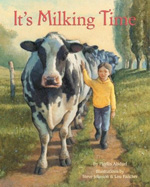 The lines “Every morning, every night, it’s milking time,” thread through each page in this gentle memoir from the author’s childhood on a dairy farm in southern Minnesota. A young girl and her father go about the daily routine of caring for and milking their cows. Since many children today probably have little knowledge of where milk really comes from, the author has created this story to depict the daily work involved in getting milk from the farm to the table to the market. The relationship between the young girl and her father quietly working together adds to the book’s special feel. The illustrators have used acrylic paint to provide a gentle touch to the pictures of the farm routines portrayed in a nostalgic manner. Poetically written, this book will make a wonderful read aloud not only about girls and their fathers but for any pre-field trip to a local farm. Teachers may want to read more about the author’s background that contributed to the book at her website.
The lines “Every morning, every night, it’s milking time,” thread through each page in this gentle memoir from the author’s childhood on a dairy farm in southern Minnesota. A young girl and her father go about the daily routine of caring for and milking their cows. Since many children today probably have little knowledge of where milk really comes from, the author has created this story to depict the daily work involved in getting milk from the farm to the table to the market. The relationship between the young girl and her father quietly working together adds to the book’s special feel. The illustrators have used acrylic paint to provide a gentle touch to the pictures of the farm routines portrayed in a nostalgic manner. Poetically written, this book will make a wonderful read aloud not only about girls and their fathers but for any pre-field trip to a local farm. Teachers may want to read more about the author’s background that contributed to the book at her website.
- Karen Hildebrand, Ohio Library and Reading Consultant
Clements, Andrew. (2012). Because your mommy loves you. Illus. by R.W. Alley. New York: Clarion Books.
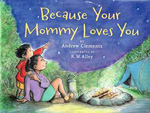 This new title is a companion book to Clements’ 2005 book, Because Your Daddy Loves You, but now the scene shifts to a mother and son camping trip to White Mountain National Forest. From the beginning when the young boy gets lost in the grocery store while they are buying supplies for the trip, his mother doesn’t come to his rescue but calls his name softly so that he can find her. After all, he is the one who wandered off. This is just the first of many scenarios in which the mother is patiently teaching her son self-reliance. For instance, as the two of them backpack into the woods and have to cross a log bridge, Mother goes first to show her son how it’s done. Later, after burning a few marshmallows, they both get to enjoy a really yummy toasted marshmallow treat. Each little episode repeats the phrase, “Your mommy could say … But she doesn’t.” As in the earlier title, the illustrations are created with ink, watercolor and acrylics, and depict the gentle nature of the story as well as the beauty of the outdoors. Readers will watch as the young boy grows in confidence and pride as he develops new skills and independence. Readers may enjoy visiting the author’s website to find fun extras about writing.
This new title is a companion book to Clements’ 2005 book, Because Your Daddy Loves You, but now the scene shifts to a mother and son camping trip to White Mountain National Forest. From the beginning when the young boy gets lost in the grocery store while they are buying supplies for the trip, his mother doesn’t come to his rescue but calls his name softly so that he can find her. After all, he is the one who wandered off. This is just the first of many scenarios in which the mother is patiently teaching her son self-reliance. For instance, as the two of them backpack into the woods and have to cross a log bridge, Mother goes first to show her son how it’s done. Later, after burning a few marshmallows, they both get to enjoy a really yummy toasted marshmallow treat. Each little episode repeats the phrase, “Your mommy could say … But she doesn’t.” As in the earlier title, the illustrations are created with ink, watercolor and acrylics, and depict the gentle nature of the story as well as the beauty of the outdoors. Readers will watch as the young boy grows in confidence and pride as he develops new skills and independence. Readers may enjoy visiting the author’s website to find fun extras about writing.
- Karen Hildebrand, Ohio Library and Reading Consultant
Egan, Kate. (2012). Kate and Nate are running late! Illus. by Dan Yaccarino. New York: Feiwel and Friends.
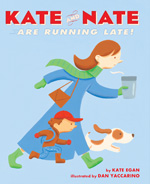 Told in a rhyming cadence, the story begins in a hectic way on one morning when Nate runs into his mother’s bedroom, leaps onto her bed, and announces that they are late. For single-mom Kate, this is not unusual, and she has her routine down pat. She leaps out of bed, robe flying, and dashes to the kitchen where she throws on the coffee and slaps breakfast together. Nate and his older sister, Maddie, begin their own preparations to hurriedly dash off to school. It isn’t easy, though, when pets have to be taken care of, lost socks found, backpacks gathered, and forgotten toys found. In the rush outside, Nate slips in a puddle. The gouache illustrations are caricature-like and add to the humor. On a final double-page spread, the little family squeals tires to get to school on time only to find out … it’s Saturday! All for naught! Readers will enjoy the illustrator’s website.
Told in a rhyming cadence, the story begins in a hectic way on one morning when Nate runs into his mother’s bedroom, leaps onto her bed, and announces that they are late. For single-mom Kate, this is not unusual, and she has her routine down pat. She leaps out of bed, robe flying, and dashes to the kitchen where she throws on the coffee and slaps breakfast together. Nate and his older sister, Maddie, begin their own preparations to hurriedly dash off to school. It isn’t easy, though, when pets have to be taken care of, lost socks found, backpacks gathered, and forgotten toys found. In the rush outside, Nate slips in a puddle. The gouache illustrations are caricature-like and add to the humor. On a final double-page spread, the little family squeals tires to get to school on time only to find out … it’s Saturday! All for naught! Readers will enjoy the illustrator’s website.
- Karen Hildebrand, Ohio Library and Reading Consultant
Harris, Robie. (2012). Who’s in my family? All about our families. Illus. by Nadine Bernard Westcott. Somerville, MA: Candlewick.
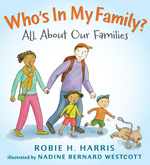 Part of a blended family themselves, Nellie and Gus become particularly aware of the infinite varieties, sizes, and compositions of families while on a trip to the zoo. While they see families just like their own, they also notice extended families and single-parent families. Not only do the children consider the different places families live, but they also recognize that different families eat various foods for breakfast. Once they return home for a family dinner, the children also discuss the physical characteristics of family members with some having mostly wavy hair and others having mostly straight hair. The digital illustrations show happy children exploring the world around them and satisfying their curiosity about the members of their own family while acknowledging that not all families are like theirs--and that's perfectly fine. This is an appealing title to add to a family text set or one on diversity. In a matter-of-fact fashion it celebrates our many similarities and differences.
Part of a blended family themselves, Nellie and Gus become particularly aware of the infinite varieties, sizes, and compositions of families while on a trip to the zoo. While they see families just like their own, they also notice extended families and single-parent families. Not only do the children consider the different places families live, but they also recognize that different families eat various foods for breakfast. Once they return home for a family dinner, the children also discuss the physical characteristics of family members with some having mostly wavy hair and others having mostly straight hair. The digital illustrations show happy children exploring the world around them and satisfying their curiosity about the members of their own family while acknowledging that not all families are like theirs--and that's perfectly fine. This is an appealing title to add to a family text set or one on diversity. In a matter-of-fact fashion it celebrates our many similarities and differences.
- Barbara A. Ward, Washington State University, Pullman
Higgins, Melissa. (2012). We all have different families. Chicago: Heinemann/Capstone Press.
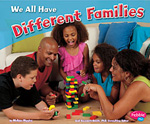 One family is often quite different from another family, and this book provides many examples of the ways each one is unique. For instance, families come in different sizes as well as different forms and configurations. While some families consist of a mother and a father, others consist of only a mother or a large extended family that includes a grandparent or aunt or even two fathers. The book also discusses foster parents and adoptions in simple, straight-forward fashion. The photos are full-page in size, showing smiling family members enjoying their time together. Representations of various cultures and types of families are included in the simple text and photographs, but all of them have one purpose: insuring that readers recognize that the one thing all of these families have in common is love for one another. A glossary, suggested readers, and websites are part of the book’s back matter.
One family is often quite different from another family, and this book provides many examples of the ways each one is unique. For instance, families come in different sizes as well as different forms and configurations. While some families consist of a mother and a father, others consist of only a mother or a large extended family that includes a grandparent or aunt or even two fathers. The book also discusses foster parents and adoptions in simple, straight-forward fashion. The photos are full-page in size, showing smiling family members enjoying their time together. Representations of various cultures and types of families are included in the simple text and photographs, but all of them have one purpose: insuring that readers recognize that the one thing all of these families have in common is love for one another. A glossary, suggested readers, and websites are part of the book’s back matter.
- Barbara A. Ward, Washington State University Pullman
Klise, Kate. (2012). Grammy Lamby and the secret handshake. Illus. by M. Sarah Klise. New York: Henry Holt.
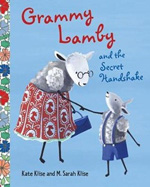 After hearing or reading this fun picture book children will automatically use “the secret handshake” when they hold a family member’s hand. Larry, who was a little lamb, didn’t care for his Grammy. When Grammy visited, she talked too much, sang too loud in church and dreamed of taking him to exotic places he didn’t want to visit. When Grammy taught him a secret handshake, he imagined it meant, “Please (squeeze). Go (squeeze). Away (squeeze)” (unpaged). But Grammy’s boisterous attitude proves to be helpful when a summer storm tears a hole in the family’s roof. Grammy immediately begins patching and repairing the home, while telling wonderful stories to Larry. She helps rebuild the community school and church. Even her sewing machine comes in handy as she makes clothes and curtains for anyone who needs them. Larry begins to see his grandmother in a different way, and when it is time for her to return home he has a special present that accompanies the secret handshake. Read Klise's "Beyond the Notebook: Start with a Transcript" on the Engage blog.
After hearing or reading this fun picture book children will automatically use “the secret handshake” when they hold a family member’s hand. Larry, who was a little lamb, didn’t care for his Grammy. When Grammy visited, she talked too much, sang too loud in church and dreamed of taking him to exotic places he didn’t want to visit. When Grammy taught him a secret handshake, he imagined it meant, “Please (squeeze). Go (squeeze). Away (squeeze)” (unpaged). But Grammy’s boisterous attitude proves to be helpful when a summer storm tears a hole in the family’s roof. Grammy immediately begins patching and repairing the home, while telling wonderful stories to Larry. She helps rebuild the community school and church. Even her sewing machine comes in handy as she makes clothes and curtains for anyone who needs them. Larry begins to see his grandmother in a different way, and when it is time for her to return home he has a special present that accompanies the secret handshake. Read Klise's "Beyond the Notebook: Start with a Transcript" on the Engage blog.
- Deanna Day, Washington State University Vancouver
Mackintosh, David. (2012). The Frank Show. New York: Harry N. Abrams.
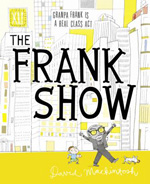 Something of a curmudgeon, the narrator's grandfather, Frank, is set in his ways, stubborn, and given to complaining. Family members have to be tolerant of each other’s eccentricities, but when the school has a show-and-tell day and the narrator must bring Frank as his guest, he is understandably anxious. After all, he hasn’t a clue about anything interesting about Frank that's worth telling to his classmates. But it turns out that Frank has had an adventurous life with a tattoo to prove it. The book explores some familiar territory about the assumptions many of us make about anyone older than forty, but it does so in a charmingly original way. It’s easy to experience the narrator's dread over what a disaster Frank’s appearance will be and then his delight at Frank’s popularity. Especially appealing is the illustration near the book's end with Frank, the star of the show, hanging out with all of the narrator's classmates. Reminding readers that everyone has a story to tell, this picture book is fun to read while providing insight into human character.
Something of a curmudgeon, the narrator's grandfather, Frank, is set in his ways, stubborn, and given to complaining. Family members have to be tolerant of each other’s eccentricities, but when the school has a show-and-tell day and the narrator must bring Frank as his guest, he is understandably anxious. After all, he hasn’t a clue about anything interesting about Frank that's worth telling to his classmates. But it turns out that Frank has had an adventurous life with a tattoo to prove it. The book explores some familiar territory about the assumptions many of us make about anyone older than forty, but it does so in a charmingly original way. It’s easy to experience the narrator's dread over what a disaster Frank’s appearance will be and then his delight at Frank’s popularity. Especially appealing is the illustration near the book's end with Frank, the star of the show, hanging out with all of the narrator's classmates. Reminding readers that everyone has a story to tell, this picture book is fun to read while providing insight into human character.
- Barbara A. Ward, Washington State University Pullman
McPhail, David. (2012). The family tree. New York: Henry Holt.
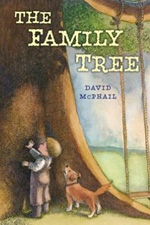 This gentle story, told in sparse text, spans five generations. In the opening scenes, the family arrives in covered wagons to build a new home. They clear the land and build their house. However, one tree is saved to provide shade for the new home. The years go by and the country gets more and more developed, until the contemporary time comes when a work crew arrives to cut down the tree to make room for a highway. The great-great-grandson of the original owner decides to protest the cutting of this tree and stands in front of the tree and declares, “Not this tree.” The forest animals join the protest and move in to offer additional help and protest. Eventually a compromise is reached, and in a double page spread readers will see a new highway cutting a wide path around the tree. Reminiscent of Virginia Burton’s The Little House, this book makes an up to date environmental statement. For a detailed background on the author, visit Sharon McElmeel’s website.
This gentle story, told in sparse text, spans five generations. In the opening scenes, the family arrives in covered wagons to build a new home. They clear the land and build their house. However, one tree is saved to provide shade for the new home. The years go by and the country gets more and more developed, until the contemporary time comes when a work crew arrives to cut down the tree to make room for a highway. The great-great-grandson of the original owner decides to protest the cutting of this tree and stands in front of the tree and declares, “Not this tree.” The forest animals join the protest and move in to offer additional help and protest. Eventually a compromise is reached, and in a double page spread readers will see a new highway cutting a wide path around the tree. Reminiscent of Virginia Burton’s The Little House, this book makes an up to date environmental statement. For a detailed background on the author, visit Sharon McElmeel’s website.
- Karen Hildebrand, Ohio Library and Reading Consultant
Manushkin, Fran. (2012). Big sisters are best. Illus. by Kirsten Richards. Mankato, MN: Picture Window Books.
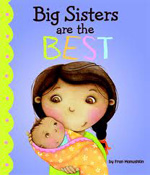 New additions to a family may be hard for children to accept, and this simple story follows a young girl as she learns to love her new sibling and to help her parents care for "our baby" (unpaged). One of the most impressive aspects of this appealing account is how the parents reserved time for their first-born child rather than lavishing all their attention and affection on the newborn. This simple action helps her see that she is loved for herself and not what she can do for the family’s new addition. While being a big sister is a pretty cool role, there’s more to the main character than that, and her identity shouldn’t be wrapped up in being a sibling. The message here is positive, accentuated by the illustrations depicting rosy cheeks and smiling faces amid at atmosphere of trust, love, and acceptance. This would be a great title for anyone whose family is growing larger.
New additions to a family may be hard for children to accept, and this simple story follows a young girl as she learns to love her new sibling and to help her parents care for "our baby" (unpaged). One of the most impressive aspects of this appealing account is how the parents reserved time for their first-born child rather than lavishing all their attention and affection on the newborn. This simple action helps her see that she is loved for herself and not what she can do for the family’s new addition. While being a big sister is a pretty cool role, there’s more to the main character than that, and her identity shouldn’t be wrapped up in being a sibling. The message here is positive, accentuated by the illustrations depicting rosy cheeks and smiling faces amid at atmosphere of trust, love, and acceptance. This would be a great title for anyone whose family is growing larger.
- Barbara A. Ward, Washington State University Pullman
Rissman, Rebecca. (2012). What is a family? Chicago, IL: Heinemann/Capstone Global Library.
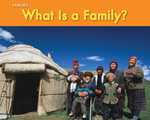 The Common Core State Standards suggest that students read more nonfiction literature. This book, part of a new series on families, could help teach young learners understand how families are different and that a family need not be limited to direct relatives. Each of the titles in this series contains a table of contents, bold headings, highlighted vocabulary words, photographs and an index. In addition, there is a note for parents and teachers on how to read and share this book with children. This particular book asks, “What is a family?” (p. 4). The colorful photographs showcase how different families are by answering, “A family is a group of people who care for each other” (p. 4). After discussing siblings, cousins, aunts, uncles, and grandparents, the text then highlights foster parents—adults who care for children to whom they are not related. The text says, “Foster parents help keep children safe” (p. 18). An illustration of a family tree with the different members that make up a family closes the book.
The Common Core State Standards suggest that students read more nonfiction literature. This book, part of a new series on families, could help teach young learners understand how families are different and that a family need not be limited to direct relatives. Each of the titles in this series contains a table of contents, bold headings, highlighted vocabulary words, photographs and an index. In addition, there is a note for parents and teachers on how to read and share this book with children. This particular book asks, “What is a family?” (p. 4). The colorful photographs showcase how different families are by answering, “A family is a group of people who care for each other” (p. 4). After discussing siblings, cousins, aunts, uncles, and grandparents, the text then highlights foster parents—adults who care for children to whom they are not related. The text says, “Foster parents help keep children safe” (p. 18). An illustration of a family tree with the different members that make up a family closes the book.
- Deanna Day, Washington State University Vancouver
Sitomer, Alan. (2012). Daddies do it different. Illus. by Abby Carter. New York: Disney-Hyperion.
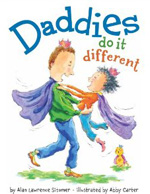 Based on his own experiences as a young father, the author has written a playful look at the differences between a mother and father through the day as told through the voice of their young daughter. When Mother gets her ready for the day, the child’s clothes are fashionably put together complete with matching socks and barrettes. When Dad is in charge, the stripes and plaids and crooked hairpins seem to get the job done. While Mom always prepares a nutritious breakfast, Dad’s turn at breakfast offers waffles heaped into a fort with syrup ending up everywhere including topping the dog. Although a bit stereotypical, the story’s intent is playful and fun. The watercolor illustrations add to the text’s humor with cartoon-like pictures that frolic alongside Sitomer’s repeated phrase that, “Daddies do it different.” At the end of the day, however, when it is time for bed, both parents tuck their daughter in with a kiss and tell her they love her in exactly the same way. Readers will enjoy learning more about the author and this book at his website. And check out his Engage blog series "A Fun Look at Our Serious Work."
Based on his own experiences as a young father, the author has written a playful look at the differences between a mother and father through the day as told through the voice of their young daughter. When Mother gets her ready for the day, the child’s clothes are fashionably put together complete with matching socks and barrettes. When Dad is in charge, the stripes and plaids and crooked hairpins seem to get the job done. While Mom always prepares a nutritious breakfast, Dad’s turn at breakfast offers waffles heaped into a fort with syrup ending up everywhere including topping the dog. Although a bit stereotypical, the story’s intent is playful and fun. The watercolor illustrations add to the text’s humor with cartoon-like pictures that frolic alongside Sitomer’s repeated phrase that, “Daddies do it different.” At the end of the day, however, when it is time for bed, both parents tuck their daughter in with a kiss and tell her they love her in exactly the same way. Readers will enjoy learning more about the author and this book at his website. And check out his Engage blog series "A Fun Look at Our Serious Work."
- Karen Hildebrand, Ohio Library and Reading Consultant
Verplancke, Klaus. (2012). Applesauce. Toronto: Groundwood Books/House of Anansi Press.
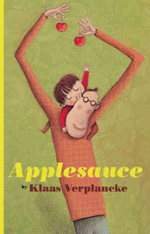 Although Johnny's father lovingly spends time with him and even painstakingly prepares applesauce for his son, there are other times when he's too tired to play or annoyed with him. But when his father sets limits or tells him to do his chores, Johnny becomes angry and wishes for a different father. After sulking and wandering into the woods, he returns home to feast on applesauce once again, confident in his father’s love. The colored pencil and acrylic illustrations show Johnny's reactions vividly while in his imagination, his angry father resembles a savage beast, eyes flashing, lips thinned in annoyance, fingers pointing, and face covered with hair. After Johnny has calmed down, he realizes that his father still loves him, and his beast-like qualities have softened. Intended to reassure young readers that love transcends anger, this picture book may prompt reflection about the messages we deliver to the children in our lives, and how those messages may be received.
Although Johnny's father lovingly spends time with him and even painstakingly prepares applesauce for his son, there are other times when he's too tired to play or annoyed with him. But when his father sets limits or tells him to do his chores, Johnny becomes angry and wishes for a different father. After sulking and wandering into the woods, he returns home to feast on applesauce once again, confident in his father’s love. The colored pencil and acrylic illustrations show Johnny's reactions vividly while in his imagination, his angry father resembles a savage beast, eyes flashing, lips thinned in annoyance, fingers pointing, and face covered with hair. After Johnny has calmed down, he realizes that his father still loves him, and his beast-like qualities have softened. Intended to reassure young readers that love transcends anger, this picture book may prompt reflection about the messages we deliver to the children in our lives, and how those messages may be received.
- Barbara A. Ward, Washington State University Pullman
Walsh, Melanie. (2012). Living with mom and living with dad. Somerville, MA: Candlewick.
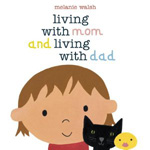 With approximately half of all marriages ending in divorce there are many children who live with one or both divorced parents throughout America. This simple picture book begins with, “My mom and dad don’t live together anymore. So sometimes I live here, with my mom and my cat in our house with the pink door…” (unpaged). In the accompanying illustration a little girl peeks out one window while her mother looks out of another one, and their black cat is sitting on the front stoop. Children will delight in the opportunity to lift a flap that reveals another home showing the little girl with her father and dog. The text continues, “And sometimes I live with my dad in our apartment at the top of the building!” (unpaged). The book continues in this manner, comparing and contrasting the two different places she calls home where she lives with each parent. Each page features a flap to help children interact with the book even more. The book concludes with the reminder that while they are no longer together, her Mom and her Dad love her very much, and so does everyone else in her family.
With approximately half of all marriages ending in divorce there are many children who live with one or both divorced parents throughout America. This simple picture book begins with, “My mom and dad don’t live together anymore. So sometimes I live here, with my mom and my cat in our house with the pink door…” (unpaged). In the accompanying illustration a little girl peeks out one window while her mother looks out of another one, and their black cat is sitting on the front stoop. Children will delight in the opportunity to lift a flap that reveals another home showing the little girl with her father and dog. The text continues, “And sometimes I live with my dad in our apartment at the top of the building!” (unpaged). The book continues in this manner, comparing and contrasting the two different places she calls home where she lives with each parent. Each page features a flap to help children interact with the book even more. The book concludes with the reminder that while they are no longer together, her Mom and her Dad love her very much, and so does everyone else in her family.
- Deanna Day, Washington State University Vancouver
Wells, Rosemary. (2012). Yoko learns to read. New York: Hyperion.
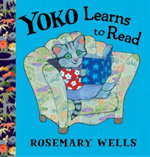 When Yoko’s teacher motivates her beginning readers by awarding a leaf for every book they read, Yoko is eager to earn even more leaves for the school book tree. However, since she has only three books at home, she and her mother head to the library for easy-to-read titles. As Yoko learns new words, she gains confidence, and inspires her mother, who only knows Japanese, to learn to read in English too. Yoko's steadfast determination to master reading amid the naysaying of some of her bullying classmates and with her mother’s constant support shines through the book’s illustrations that show her eager-eyed wonder as the world of words opens up before her. The illustrations, rendered in oil pastel and collage and brimming with swirling colors and cats representing humans dressed in vivid kimonos, are particularly eye-catching as are the endpapers filled with replicas of the one-syllable word cards and images used by someone cracking the alphabetic code and learning word families. Together, the illustrations and text capture perfectly the joy with which Yoko celebrates her ability to read better with each book she tackles.
When Yoko’s teacher motivates her beginning readers by awarding a leaf for every book they read, Yoko is eager to earn even more leaves for the school book tree. However, since she has only three books at home, she and her mother head to the library for easy-to-read titles. As Yoko learns new words, she gains confidence, and inspires her mother, who only knows Japanese, to learn to read in English too. Yoko's steadfast determination to master reading amid the naysaying of some of her bullying classmates and with her mother’s constant support shines through the book’s illustrations that show her eager-eyed wonder as the world of words opens up before her. The illustrations, rendered in oil pastel and collage and brimming with swirling colors and cats representing humans dressed in vivid kimonos, are particularly eye-catching as are the endpapers filled with replicas of the one-syllable word cards and images used by someone cracking the alphabetic code and learning word families. Together, the illustrations and text capture perfectly the joy with which Yoko celebrates her ability to read better with each book she tackles.
- Barbara A. Ward, Washington State University Pullman
GRADES 4-6
Adderson, Caroline. (2012). Middle of nowhere. Toronto: Groundwood Books.
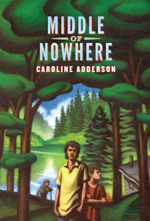 Although Curtis is one hundred percent positive that his mother will come back soon from wherever she is, another part of him doubts that she will. After all, she's left him before, prompting an unhappy stay in a foster home. With each passing day, Curtis’s doubts increase. Curtis begins running errands for their elderly neighbor Mrs. Burt, and eventually the boys come to confide and trust in her. Eventually, she concocts a plan involving a road trip to a family cabin near a lake far from their home, certain that the distance and isolation will keep the police and social services from bothering them. The boys have the time of their lives at the cabin, and Artie faces many of his fears. Curtis, however, can't quit thinking about his mother, and wants to head back to town. The book has many unexpected twists and turns, and the kindly Mrs. Burt turns out not to have been as truthful as she might have been in her own desire to cobble together a family while also maintaining a level of independence. The author skillfully plays with many readers’ assumptions about family and maternal instincts, revealing that making one mistake doesn't make someone a bad mother. Any mother whose sole treasure is the first baby tooth lost by a child can't be all bad.
Although Curtis is one hundred percent positive that his mother will come back soon from wherever she is, another part of him doubts that she will. After all, she's left him before, prompting an unhappy stay in a foster home. With each passing day, Curtis’s doubts increase. Curtis begins running errands for their elderly neighbor Mrs. Burt, and eventually the boys come to confide and trust in her. Eventually, she concocts a plan involving a road trip to a family cabin near a lake far from their home, certain that the distance and isolation will keep the police and social services from bothering them. The boys have the time of their lives at the cabin, and Artie faces many of his fears. Curtis, however, can't quit thinking about his mother, and wants to head back to town. The book has many unexpected twists and turns, and the kindly Mrs. Burt turns out not to have been as truthful as she might have been in her own desire to cobble together a family while also maintaining a level of independence. The author skillfully plays with many readers’ assumptions about family and maternal instincts, revealing that making one mistake doesn't make someone a bad mother. Any mother whose sole treasure is the first baby tooth lost by a child can't be all bad.
- Barbara A. Ward, Washington State University Pullman
Atinuke. (2012). The No. 1 Car Spotter and the Firebird. New York: Walker & Company.
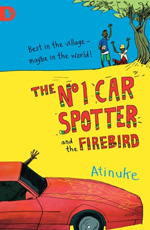 This short chapter book featuring the No. 1 Car Spotter in the Village is just as delightful as the first one. Although No. 1's ideas often meet with resistance from his family members at first, eventually they turn out to be creative solutions to problems. For example, when a leopard preys on the villagers' goats, No. 1 is unable to use a slingshot skillfully enough to frighten the leopard away, but he coats a shirt with chili pepper soup and wraps it around the goat. When the leopard gets a taste of the hot stuff, he runs away with a burning taste in his mouth. One of the hilarious aspects of the story has to do with his suggestion that Mama Coca-Cola build a house made of cement with results that are totally unexpected. Every page in this title shows the affection family members have for one another even through life’s challenges.
This short chapter book featuring the No. 1 Car Spotter in the Village is just as delightful as the first one. Although No. 1's ideas often meet with resistance from his family members at first, eventually they turn out to be creative solutions to problems. For example, when a leopard preys on the villagers' goats, No. 1 is unable to use a slingshot skillfully enough to frighten the leopard away, but he coats a shirt with chili pepper soup and wraps it around the goat. When the leopard gets a taste of the hot stuff, he runs away with a burning taste in his mouth. One of the hilarious aspects of the story has to do with his suggestion that Mama Coca-Cola build a house made of cement with results that are totally unexpected. Every page in this title shows the affection family members have for one another even through life’s challenges.
- Barbara A. Ward, Washington State University Pullman
Lean, Sarah. (2012). A dog called Homeless. New York: Katherine Tegen Books.
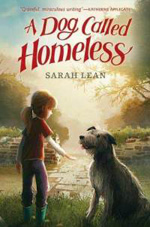 Fifth-grader Cally Fisher lost her mother a year ago. Her father and brother, Luke, are not handling their grief very well. Cally’s father has become closed off and withdrawn while Luke seems to have disappeared into the world of video games. Cally is yearning to talk with someone about her mother when she begins seeing her mother in various places – or is it a ghost? Her father tells her she is imagining things and will discuss it no further. In addition to her mother’s spirit, a strange and possibly homeless dog appears whenever her mother is around. As Cally continues to question what is really happening here, a charity fund-raiser at school requires the students to be silent for a day. Comfortable with the silence, Cally decides to continue not to speak. When the family has to move, Cally soon meets Sam, her downstairs apartment neighbor who is blind and nearly deaf. As a friendship blossoms, so does an understanding of surviving difficult situations. This first novel from Sarah Lean offers a tender and thoughtful story about life, loss and healing to middle grade readers. Readers may be interested in visiting the author’s website devoted to this book. It includes a variety of resources and extension activities.
Fifth-grader Cally Fisher lost her mother a year ago. Her father and brother, Luke, are not handling their grief very well. Cally’s father has become closed off and withdrawn while Luke seems to have disappeared into the world of video games. Cally is yearning to talk with someone about her mother when she begins seeing her mother in various places – or is it a ghost? Her father tells her she is imagining things and will discuss it no further. In addition to her mother’s spirit, a strange and possibly homeless dog appears whenever her mother is around. As Cally continues to question what is really happening here, a charity fund-raiser at school requires the students to be silent for a day. Comfortable with the silence, Cally decides to continue not to speak. When the family has to move, Cally soon meets Sam, her downstairs apartment neighbor who is blind and nearly deaf. As a friendship blossoms, so does an understanding of surviving difficult situations. This first novel from Sarah Lean offers a tender and thoughtful story about life, loss and healing to middle grade readers. Readers may be interested in visiting the author’s website devoted to this book. It includes a variety of resources and extension activities.
- Karen Hildebrand, Ohio Library and Reading Consultant
GRADES 7-8
Creech, Sharon. (2012). The great unexpected. New York: HarperCollins.
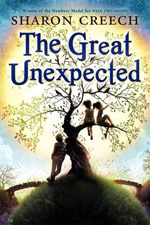 There are two narrative strands at work in this novel that bears some resemblance to Charles Dickens' Great Expectations. Two orphans, Naomi Deane and Lizzie Scatterding, become best friends while living with families in the small town of Blackbird Tree, but their friendship is threatened when a boy named Finn literally falls through a tree. Naomi is strangely drawn to him and anxious that he might be attracted to her friend. Meanwhile, in Ireland, a wealthy woman named Mrs. Kavanaugh is busily concocting her revenge. Although there are references to murder and hints of revenge that may lead readers to assume the worst of Mrs. Kavanaugh, she turns out not to be the villain of the book. In fact, her revenge comes from giving gifts to those who don’t expect them. The notion that there are often unexpected, mysterious connections among individuals that somehow shape lives and change fortunes is a powerful idea that moves throughout the book, heightening readers’ enjoyment. As that Finn boy causes the same sort of problems between Naomi and Lizzie as he did in an earlier generation, the past and the present seem to collide improbably. In the end, unanticipated love, fortune, friendship, and forgiveness change the characters’ lives in unexpected ways.
There are two narrative strands at work in this novel that bears some resemblance to Charles Dickens' Great Expectations. Two orphans, Naomi Deane and Lizzie Scatterding, become best friends while living with families in the small town of Blackbird Tree, but their friendship is threatened when a boy named Finn literally falls through a tree. Naomi is strangely drawn to him and anxious that he might be attracted to her friend. Meanwhile, in Ireland, a wealthy woman named Mrs. Kavanaugh is busily concocting her revenge. Although there are references to murder and hints of revenge that may lead readers to assume the worst of Mrs. Kavanaugh, she turns out not to be the villain of the book. In fact, her revenge comes from giving gifts to those who don’t expect them. The notion that there are often unexpected, mysterious connections among individuals that somehow shape lives and change fortunes is a powerful idea that moves throughout the book, heightening readers’ enjoyment. As that Finn boy causes the same sort of problems between Naomi and Lizzie as he did in an earlier generation, the past and the present seem to collide improbably. In the end, unanticipated love, fortune, friendship, and forgiveness change the characters’ lives in unexpected ways.
- Barbara A. Ward, Washington State University Pullman
GRADES 9-12
Hartman, Brett. (2012). Cadillac chronicles. El Paso, TX: Cinco Puntos Press.
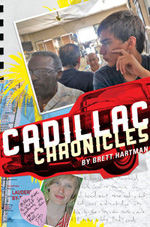 Although the road traveled in this novel by a debut YA author has been well-traveled by others, it's hard not to root for sixteen-year-old protagonist Alex Riley as he figures out where he belongs. Alex and his mother don't get along, and he knows next to nothing about his father who lives in Florida. Because it will make her look good and advance her political career, Alex's mother agrees to take in elderly Lester Bray but then changes her mind after he proves to be too troublesome. As Alex becomes increasingly annoyed with his mother, he and Lester set off on a road trip in Lester's Cadillac. Enroute from New York to the South, the two bond as Alex learns the truth about his father’s sexual identity and loses his own virginity while visiting Lester's hometown. Conversations with Lester and detours help Alex come to understand himself better and develop tolerance for those around him, including his own family members. Readers will certainly fall in love with Selma who deflowers Alex and shows him how to please her physically. While road trips may provide opportunities for growth and self-reflection, so can practicing a little patience and listening to others. Teen readers will look forward to the next title from this author who balances humor and pathos so skillfully.
Although the road traveled in this novel by a debut YA author has been well-traveled by others, it's hard not to root for sixteen-year-old protagonist Alex Riley as he figures out where he belongs. Alex and his mother don't get along, and he knows next to nothing about his father who lives in Florida. Because it will make her look good and advance her political career, Alex's mother agrees to take in elderly Lester Bray but then changes her mind after he proves to be too troublesome. As Alex becomes increasingly annoyed with his mother, he and Lester set off on a road trip in Lester's Cadillac. Enroute from New York to the South, the two bond as Alex learns the truth about his father’s sexual identity and loses his own virginity while visiting Lester's hometown. Conversations with Lester and detours help Alex come to understand himself better and develop tolerance for those around him, including his own family members. Readers will certainly fall in love with Selma who deflowers Alex and shows him how to please her physically. While road trips may provide opportunities for growth and self-reflection, so can practicing a little patience and listening to others. Teen readers will look forward to the next title from this author who balances humor and pathos so skillfully.
- Barbara A. Ward, Washington State University Pullman
These reviews are submitted by members of the International Reading Association's Children's Literature and Reading Special Interest Group (CL/R SIG) and are published weekly on Reading Today Online. The International Reading Association partners with the National Council of Teachers of English and Verizon Thinkfinity to produce ReadWriteThink.org, a website devoted to providing literacy instruction and interactive resources for grades K–12.